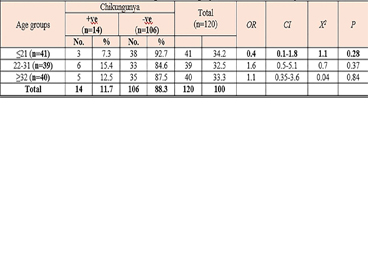Personal and environmental risk factors for chikungunya virus infection: cross-sectional hospital-based study among febrile patients receiving treatment in AI-Hodayda city hospitals, Yemen
محتوى المقالة الرئيسي
الملخص
Background: Mosquitoes carry the illness known as chikungunya, which is becoming more common throughout Yemen. It is a serious matter concerning public health. In the hospitals located in AI-Thawrah, AI-Amal, and AI-Aqsa in AI-Hodayda city, Yemen, feverish patients seeking treatment were the subjects of this study, which aimed to investigate host and environmental risk factors.
Methods: Patients with fever were enrolled in the trial at the authorized hospitals in AI-Hodayda city between June and June 2023. For febrile patients, a set of questionnaires was employed to collect clinical, sociodemographic, and related risk factors. Using an enzyme-linked immunosorbent assay, patients were tested for chikungunya antibodies as well as immunoglobulin M (IgM) and G (IgG). Reverse transcriptase polymerase chain reaction (RT-PCR), which searches for CHIK viral RNA, was used to confirm the findings.
Results: In all, 120 patients with fever were included in the research. According to RT-PCR, ELISA, and/or RDTs, the total prevalence of chikungunya infection was 14 (11.7%). The study found a correlation between gender and chikungunya infection, with males having a slightly higher rate (12.2%) compared to females (10.9%). The age group of 22-31 years had a higher rate (15.4%) than the ≤21 (7.3%) and a slightly higher (12.5%) group of ≥32 years. The study also identified risk factors associated with chikungunya infections in individuals experiencing fever in Hodiedah city. These included living in a rural area, living in a bog, lacking sewage in homes, failing to use a bed net, having an exposed water tank, not having a window screen, not wearing full body cloths, having trash around or near the patients' houses, and having another ill person with a fever of unknown origin in the patients' houses.
Conclusions: The research involved 120 patients with fever, revealing a 11.7% prevalence of chikungunya infection. Gender was found to be a significant factor, with males having a slightly higher rate. Age groups 22-31 had a higher rate than other age groups. Risk factors associated with chikungunya infections included rural living, bog living, lack of sewage, bed net use, exposed water tanks, and trash.
التنزيلات
تفاصيل المقالة

هذا العمل مرخص بموجب Creative Commons Attribution-NonCommercial-NoDerivatives 4.0 International License.

